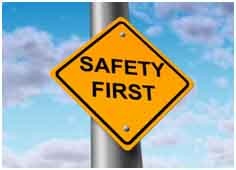By Sara Peters, Fauske & Associates, LLC (FAI)
“安全文化”是一个经常听到的词d referenced around our engineering and testing lab Fauske & Associates, LLC (FAI) ─ both as it pertains to our customers and in our own daily business practices. But, recently it occurred to me that if one does not work in my business they might be asking ‘what exactly is a safety-first culture and how is it relevant?’
安全文化定义
The International Nuclear Safety Advisory Group (INSAG) is credited with coining the term in their report on the Chernobyl incident published in 1986.1INSAG defined it as “The assembly of characteristics and attitudes in organizations and individuals which establishes that, as an overriding priority, protection and safety issues receive the attention warranted by their significance.”2
Since then, numerous other definitions of the term have emerged from various sources. A commonly cited one provided by the U.S. NRC (United States Nuclear Regulatory Commission) which defines it as, “The core values and behaviors resulting from a collective commitment by leaders and individuals toemphasize safety超越竞争目标,以确保保护人民和环境。”3Incidentally, this is the definition we apply to our business.
No surprise that these two are very similar, as are most that I looked at – largely dealing with the values, attitudes and behaviors that are used within an organization to establish safety as a priority in the workplace. And, although it has roots in the nuclear power industry, its relevance extends far beyond into any industry that wants to operate safely at high levels of performance. So, now that you have an idea of what it is, how do you apply a culture of safety to your business?
A Culture of Safety Applied
安全文化是一种理想的理想,应该在整个组织文化中根深蒂固,并每天从组织的最高层次中加强整个行列。它结合了许多特征,包括领导安全价值,问题识别和解决方案以及个人问责制,仅举几例。4我们的管理层长期以来一直认为,要成为一家企业,我们必须将安全放在首位。这也是我们公司的管理层和创始人继续向员工,客户和同事重申。
在最近在2015年春季发行的一篇文章中过程安全新闻and as a blog on our website, FAI founders Dr. Hans Fauske and Dr. Robert Henry gave the following response when asked to talk about what they see as the biggest change for the near future of process safety based on what they have seen to date?:
Fauske博士:
“The biggest change that I would like to see is basically making process safety a number one priority, even before profit. That’s a tough one, but I think it’s needed. I talk to a lot of people, customers and so on, and they say, ‘you well know the upper management isn’t willing to spend the money, it’s too costly.’ But it really comes down to a culture of safety. You need to have a safety process in a company, and you need to practice it, not now and then, but all the time. And particularly it has to come from up above, the president, the chairman or whoever is the top guy. It’s very important. And, I think if you are going to improve the industry from a safety point of view that’s got to take place. And in some companies, that is the case. You may have a good company doing all the right things and you never really have a serious incident. But, if you have another company that has a big one, that affects everybody, and that’s important.”
亨利博士:
“I’m not quite sure where to even start on this but it is extremely important. I can’t tell you how many times in discussions of all these types of possible accident conditions that we have to take care of or to at least address or think through - that the subject has come up ‘well that’s never happened.’ And, a lot of people fall into the trap that if it hasn’t happened before then it isn’t going to happen.
Most of the time, we are dealing with things that are very low probability, but they still happen and, sometimes the consequences are considerable, just like Chernobyl. But the other side of the coin, if you’re going to have an environment of safety, when the problem is solved you say it’s solved. You don’t just continue to milk it and let it hang on because all you are doing is diffusing the focus on the real activities that are needed.”5
在FAI,我们亲眼目睹了强大的安全第一文化的好处,以“安全性是优先权,质量为标准”的座右铭。对安全的奉献精神使我们能够建立成为核化学安全领域的世界领导者的声誉,并继续将众多行业认可的专家视为团队成员。证明这一点是,在过去的25年中遍布四个建筑物。更不用说我们强大的安全第一文化导致了更好的产品和服务,这使我们能够始终如一地为客户和合作伙伴所期望的出色客户服务提供优质的客户服务。
我们是完美的吗?不,我们一直在改善和发展。但是,作为一家致力于为客户促进行业安全和流程安全的公司,我们借鉴了自己的奉献精神,以帮助我们的客户开发工具来培养一种组织文化,从而促进对安全的积极态度。
需要帮助了解如何建立更好的安全环境或文化?我们可以提供帮助。联系我们info@fauske.comto learn more.
参考:














